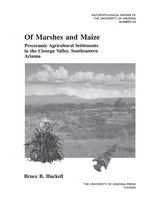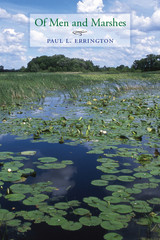3 books about Marshes

The Marshes of Southwestern Lake Erie
Louis W. Campbell
Ohio University Press, 1994
The marshes along the Ohio shore of Lake Erie represent less than ten percent of the vast wetlands that were there two hundred years ago. Virtually unknown outside the region and, indeed, little known even by area residents, the western Lake Erie marshes are among the most mysterious, beautiful, and vulnerable of all the wild lands remaining in Ohio. Constantly threatened throughout the years with destruction by high lake waters or human enterprises, they have been critically important to the large populations of migrating waterfowl, raptors, and songbirds that twice a year face the treacherous air currents above the lake.
This book explores both the human and natural history of the marshes between Toledo and Port Clinton, Ohio. The author, Louis Campbell is the acknowledged authority on the birds of the Toledo area. Mr. Campbell began weekly birding trips to the marshes in the 1920’s, carefully recording his observations. His discerning eye and inquiring mind have accumulated a wealth of information, presented here in a style that is comfortably conversational, whether the subject is glacial moraines, nesting eagles, or a drunken meadow mouse.
The book begins with an almanac, a celebration of marsh life throughout the year, enriched by personal experiences. Mr. Campbell’s encounters include a pair of bloodthirsty shrews, a roguish gallery of courting waterfowl, and a rhythm-challenged bittern. He invites the reader to share the risky pleasures of punting and the eerie night sounds of the marsh in May.
Part II describes the history of the low-lying marshes from the Ice Age to the present, as they were transformed into drained, flood-plagued farmland then to drought-and flood-plagued private hunting clubs, and finally to government-protected marshes sealed off by huge dikes from the gift and the threat of Lake Erie. Readers of this book will never again take these wetlands for granted.
This book explores both the human and natural history of the marshes between Toledo and Port Clinton, Ohio. The author, Louis Campbell is the acknowledged authority on the birds of the Toledo area. Mr. Campbell began weekly birding trips to the marshes in the 1920’s, carefully recording his observations. His discerning eye and inquiring mind have accumulated a wealth of information, presented here in a style that is comfortably conversational, whether the subject is glacial moraines, nesting eagles, or a drunken meadow mouse.
The book begins with an almanac, a celebration of marsh life throughout the year, enriched by personal experiences. Mr. Campbell’s encounters include a pair of bloodthirsty shrews, a roguish gallery of courting waterfowl, and a rhythm-challenged bittern. He invites the reader to share the risky pleasures of punting and the eerie night sounds of the marsh in May.
Part II describes the history of the low-lying marshes from the Ice Age to the present, as they were transformed into drained, flood-plagued farmland then to drought-and flood-plagued private hunting clubs, and finally to government-protected marshes sealed off by huge dikes from the gift and the threat of Lake Erie. Readers of this book will never again take these wetlands for granted.
[more]

Of Marshes and Maize
Preceramic Agricultural Settlement in the Cienega Valley, Southeastern Arizona
Bruce B. Huckell
University of Arizona Press, 1995
While it was once believed that agriculture and pottery developed concurrently in prehistoric societies, modern research has concluded that agriculture preceded pottery making, since a sedentary life with greater food production led to both the need and time to create storage containers. Bruce Huckell has been at the forefront of a movement in Arizona archaeology that has greatly modified our understanding of the transition from the Archaic to the agricultural periods in the Southwest. Work done by Huckell and others at Matty Canyon has produced the most detailed account available of a Late Archaic village and has been extremely influential in suggesting that the cultivation of maize predated the appearance of pottery. Of Marshes and Maize presents archaeological information obtained from small-scale investigations at two deeply buried preceramic sites in the Cienega Creek Basin. Its report on excavations at the Donaldson Site and at Los Ojitos offers a thorough description of archaeological features and artifacts, floral and faunal remains, and their geological and chronological contexts. From this data, the author concludes that a major shift toward a sedentary lifeway dependent on maize agriculture had already occurred by Late Archaic times (c. 500 to 800 B.C.), demonstrating that previous research on late preceramic sites in this region has provided an inadequate picture of the period. This monograph represents the first full presentation in the literature of an important set of data that is well-known among researchers but has thus far not been easily accessible. It is a classic example of the use of fragmentary evidence in well-dated contexts to introduce new ideas, and will stand not only as an important record of the evidence but also as the primary reference for this significant new interpretation of the late Archaic and the introduction of agriculture into the Southwest.
[more]

Of Men and Marshes
Paul Errington
University of Iowa Press, 1957
Standing with such environmental classics as Loren Eiseley’s TheImmense Journey, his friend and mentor Aldo Leopold’s A Sand County Almanac, and Joseph Wood Krutch’s The Voice of the Desert, Paul Errington’s Of Men and Marshes remains an evocative reminder of the great beauty and intrinsic value of the glacial marshland. Prescient and stirring, steeped in insights from Errington’s biological fieldwork, his experiences as a hunter and trapper, and his days exploring the marshes of his rural South Dakota childhood, this vibrant work of nature writing reveals his deep knowledge of the marshland environments he championed.
Examining the marsh from a dynamic range of perspectives, Errington begins by inviting us to consider how immense spans of time, coupled with profound geological events, shaped the unique marshland ecosystems of the Midwest. He then follows this wetland environment across seasons and over the years, creating a compelling portrait of a natural place too little appreciated and too often destroyed. Reminding us of the intricate relationships between the marsh and the animals who call it home, Errington records his experiences with hundreds of wetland creatures. He follows minks and muskrats, snapping turtles and white pelicans, red foxes and blue-winged teals—all the while underscoring our responsibility to preserve this remarkable and fragile environment and challenging us to change the way we think about and value marshlands.
This classic of twentieth-century nature writing, a landmark work that is still a joy to read, offers a stirring portrait of the Midwest’s endangered glacial marshland ecosystems by one of the most influential biologists of his day. A cautionary book whose advice has not been heeded, a must-read of American environmental literature, Of Men and Marshes should inspire a new generation of conservationists.
[more]
READERS
Browse our collection.
PUBLISHERS
See BiblioVault's publisher services.
STUDENT SERVICES
Files for college accessibility offices.
UChicago Accessibility Resources
home | accessibility | search | about | contact us
BiblioVault ® 2001 - 2024
The University of Chicago Press









